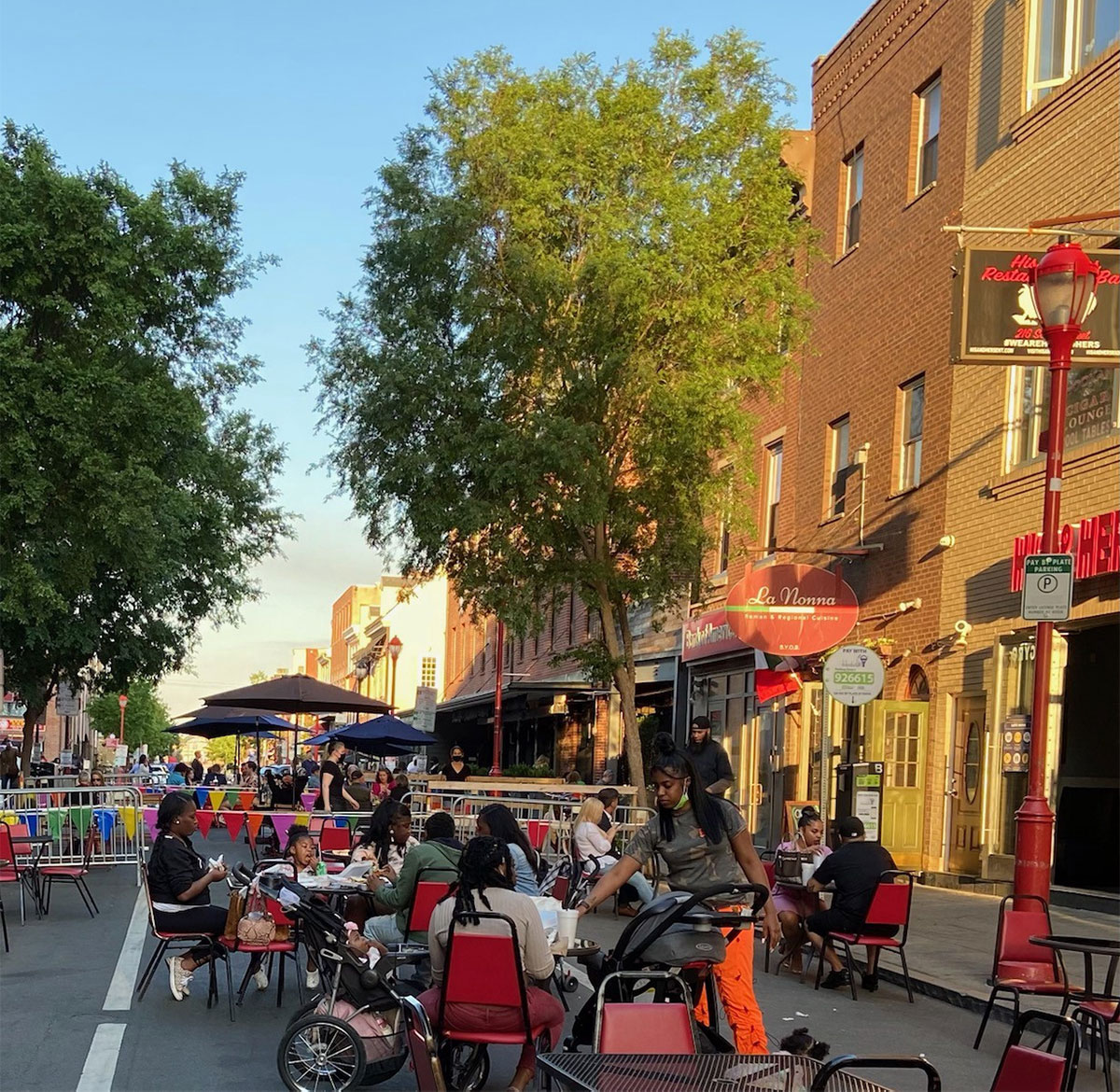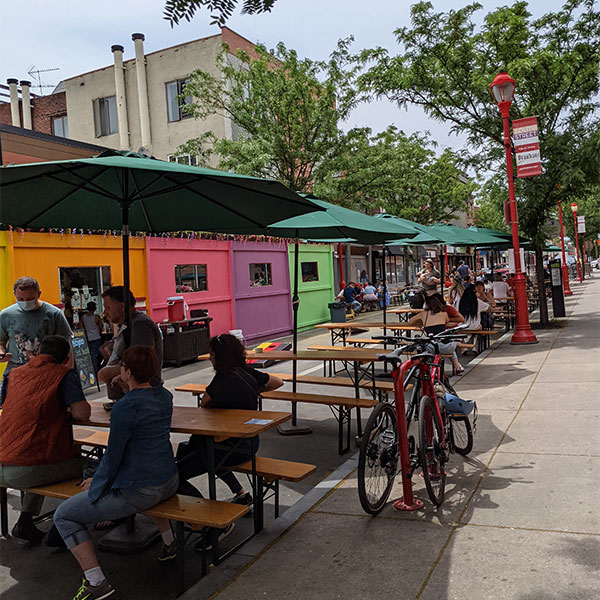21 May What’s next for Main Street?
We think data for civic engagement can help us figure it out
We at the Edit the City! team (Marisa Denker/Connect the Dots Insights, Katrina Johnston-Zimmerman/THINK.urban and Stephen Larrick/Stae) have been working hard behind the scenes thanks to an award from the Knight Foundation’s Data for Civic Engagement grant program. In collaboration with the South Street Headhouse District in Philadelphia, we’ve begun digging up civic data, formed a working committee of local stakeholders, and launched a public-facing survey—all to support efforts currently underway to co-create the future of an iconic urban main street through a series of pilot pedestrianization weekends this summer.
Check out our update on progress so far below, and stay tuned for more to come— including the results of our pre-pilot survey of nearly 2400(!) respondents and the next steps for creative engagement in the public realm as the pilot progresses.

When the Edit the City! team conceived of a project proposal for the Knight Foundation’s Data for Civic Engagement grant program, we knew that the Covid-19 pandemic was having an unprecedented impact on urban main streets. We also knew that in the case of South Street in Philadelphia, local data could play a role in engaging stakeholders at the neighborhood scale and ensuring they have a say in the recovery process.
Data is not a solution to every problem, but we wanted to know how it might facilitate a more transparent, empirical, and collaborative approach to challenges and opportunities at a hyper-local level. With this question in mind, we began project activities in early 2021 with listening, listening, and — you guessed it — more listening. From focus groups and one-on-one calls, to weekly steering committee meetings and a public survey that received nearly 2,400 responses, our approach has been to meet neighborhood stakeholders where they are in order to find opportunities for meaningful “data engagement” work that can make a difference in the lives of residents, visitors, and businesses.
Today we are reporting on our progress toward co-creating an action-oriented initiative based on leveraging neighborhood data for impact. We are happy to share that our engagement thus far has already helped to pioneer and shape a pilot open streets weekend program on South Street as a model experiment to explore the potential of people-first, car-free main streets in Philadelphia. Throughout this pilot, the Edit the City! team will be leading efforts to collect and share data to ensure that findings and feedback can be translated into more lasting, public-informed change.

Project context and how we honed in on open streets
When we were first awarded this grant in 2020, decreased commuting and low traffic volumes from Covid had created opportunities for cities to experiment with new uses of the street as a public space. Cities across the globe were inspired to pilot “open streets” or “Covid streets,” in which low-cost interventions are deployed to support outdoor gathering, physical exercise and recreation, protected travel corridors for pedestrians and cyclists, and safe dining and retail experiences for urban businesses.
After beginning engagement with the business improvement district, we saw this same excitement for new street activation approaches on South Street as well. Building off of a successful “streateries” program last summer, the work began to coordinate with the City of Philadelphia to plan a series of open streets weekends that would start with two blocks — the 200 and the 700 blocks — closed to traffic from Friday evening through Sunday, beginning on May 14 and continuing through June. The goal was to take an iterative approach to building on this experiment based on insights gathered along the way.
While the idea was exciting, there were some concerns that needed to be addressed: how might the South Street Headhouse District address potential issues associated with limited automobile access and diverted traffic? How might the District document the benefits of open streets? How might a temporary open streets pilot help bring about more permanent change? And perhaps most importantly, as South Street changes as a result of Covid or is reimagined in part via an open streets program, how might we make sure we are building on the neighborhood characteristics that make South Street unique?

The opportunity for data engagement
We see all of these questions and concerns as opportunities to collect and share open data in order to engage public stakeholders in the process. More specifically, our feeling is that this reciprocal process of “public engagement for data collection” and “data sharing for public engagement” can help with things like documenting South Street’s current assets and needs in the eyes of businesses, residents, and visitors; measuring the impact of pedestrian-only weekends; and in laying the foundation for the conversation, visioning, and action needed to translate a pilot experiment into lasting change.
Here’s how we plan to make it happen.
Stakeholder feedback as structured, qualitative data
With this vision in mind, throughout the open streets pilot we will be asking visitors, businesses and residents to think about how we can build a better South Street — how we can leverage the pilot to envision potential long-term changes to the public realm (such as pedestrianization) to reinvigorate South Street and what makes it so special.
To do this, we’ll be designing a series of creative engagement interventions, both digital and IRL (stay tuned!) embodying the quirky spirit of South Street to get at the heart of the matter for the fans and neighbors.
We want to know about South Street’s past and current, unique assets…
- What makes South Street unique?
- What memories do you have on South Street and where?
- What physical or cultural characteristics of the street make it special? What is it about South Street that you love?
…and about its future-looking needs and opportunities for change…
- If the street weren’t reserved for cars all of the time what would you want it used for?
- What changes might be needed to South Street’s physical characteristics and public infrastructure?
- What would that look like for you as a business owner, visitor, or resident?
Ultimately we’ll be structuring this feedback and ideation into an assets and opportunities map and public open data set.
Quantitative impact measures
Following the pilot we also plan to measure the impacts of pedestrian-only weekends as best we can by counting people and vehicles, and tracking other available metrics such as noise complaints , and sales or revenue data that businesses might be willing to share, or even more creative quantitative data sources such as google search results and social media engagement metrics during both regular traffic hours and during car-free open streets weekends.
We will share these quantitative measures on our Edit the City South Street open data portal alongside the stakeholder feedback assets and opportunities data. And while this “impact” data certainly won’t be scientific or be able to tell the whole story, our goal is to provide context as a starting point for neighborhood conversation.
Leveraging data collected for public-driven action
Finally we’ll be synthesizing all of that data collected — both qualitative and quantitative — together, generating public maps, reports, and open data that through a series of public forums to be held later this summer will inform both short term programming and design interventions for the street and longer term changes to the public realm.
We don’t know exactly what this will look like yet, but that’s the point: outputs will be shaped by public voices and by the needs identified throughout the pilot. Whatever form that takes, with your help, this data and the outputs it generates will help bolster and inform coordination between the BID and city hall in how learnings might be made more permanent in the future.
To learn more about our project and team, you can visit our project website or reach out to us at [email protected].
Next up: the results of our pre-pilot open streets public-facing pre-pilot survey.
